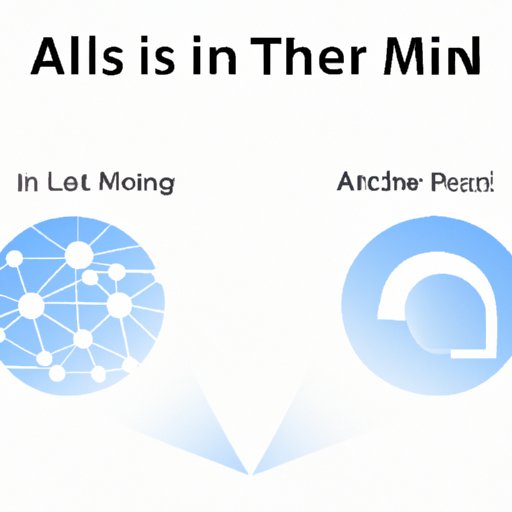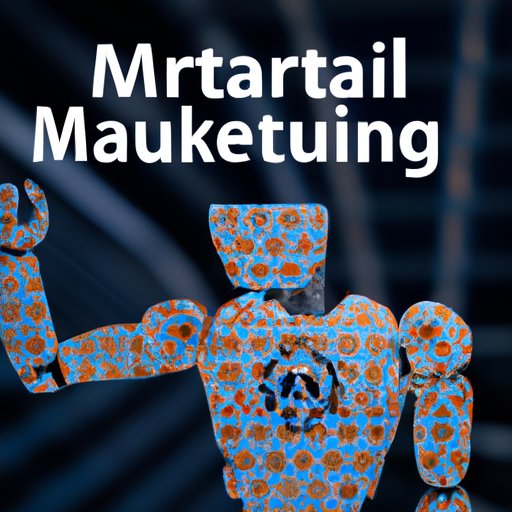Introduction
Artificial intelligence (AI) and machine learning (ML) are two terms that are often used interchangeably, but what exactly do they mean? AI is the broader concept of machines being able to carry out tasks in a way that we would consider “intelligent” while ML is a specific application of AI that enables machines to learn from data without being explicitly programmed.
In this article, we’ll look at the differences between AI and ML, explore their intersection and examine how they’re changing businesses today and impacting our future society.
A Comparison of AI and ML: What’s the Difference?
To understand the difference between AI and ML, it’s important to first define each term.
Definition of AI and ML
AI is the broadest term for any technology that enables machines to mimic human behavior. It can refer to anything from voice recognition software to self-driving cars. AI can be used to make decisions, solve problems, and automate tasks.
ML is a subset of AI that focuses specifically on the ability of machines to learn from data without being explicitly programmed. ML algorithms use data to identify patterns and make predictions. The more data they’re exposed to, the more accurate their predictions become.
Differences in Use Cases
AI is used in a wide range of applications, from healthcare to finance to marketing. ML is used to analyze large amounts of data and make predictions about future outcomes. For example, ML can be used to analyze customer data to predict future buying habits or to detect fraud in financial transactions.
Impact on Businesses
AI and ML are transforming the way businesses operate. AI can be used to automate mundane tasks, freeing up employees to focus on higher value activities. ML can help businesses make better decisions by analyzing data and making accurate predictions about customer needs and market trends.
What Role Does AI and ML Play in Modern Technology?
AI and ML are used in a variety of modern technologies, from automation and robotics to data analysis to machine learning.
Automation and Robotics
AI and ML are used to automate mundane tasks and enable robots to perform complex operations. AI-powered robots can navigate their environment and interact with humans in ways that were previously impossible. ML algorithms are used to recognize patterns in sensory input, allowing robots to respond to their environment in a more intelligent way.
Data Analysis
AI and ML can be used to analyze large datasets and extract insights from them. ML algorithms can identify patterns and correlations that are invisible to the human eye, allowing businesses to make more informed decisions.
Machine Learning
ML algorithms can be used to build models that can make predictions about future outcomes. These models can be used to automate processes and make decisions without human intervention.

Exploring the Intersection of AI and ML
The intersection of AI and ML lies in the use of ML algorithms to develop AI-driven solutions. By leveraging ML, AI systems can be trained to make decisions and take actions without explicit programming.
AI-driven Solutions
AI-driven solutions are powered by ML algorithms that enable machines to learn from data and make decisions without explicit programming. These solutions can be used to automate processes, improve decision making, and enhance customer experiences.
Leveraging ML for AI
ML algorithms can be used to create AI-driven solutions that are more efficient and accurate than traditional approaches. By leveraging ML, AI systems can be trained to recognize patterns, make predictions, and take appropriate actions without human intervention.
Enhancing Human Work
AI and ML can be used to enhance human work by automating mundane tasks and enabling faster and more accurate decision making. By leveraging AI and ML, businesses can reduce costs, increase efficiency, and improve customer experiences.
How Are AI and ML Changing Businesses Today?
AI and ML are transforming the way businesses operate. From automation and efficiency to improved decision making and enhanced customer experiences, AI and ML are having a profound impact on businesses today.
Automation and Efficiency
AI and ML can be used to automate mundane tasks and free up employees to focus on higher value activities. AI-powered robots can also be used to increase productivity and reduce costs by performing complex operations more quickly and accurately than humans.
Improved Decision Making
ML algorithms can be used to analyze large datasets and extract insights from them. This can help businesses make better decisions by identifying patterns and correlations that are invisible to the human eye.
Enhanced Customer Experience
AI and ML can be used to enhance customer experiences by understanding customer needs and preferences and providing personalized products and services. AI-powered chatbots can be used to provide 24/7 customer service, while ML algorithms can be used to recommend products and services based on individual customer data.
The Impact of AI and ML on Our Future Society
As AI and ML become more prevalent in our society, there are social, economic, and ethical implications that must be considered.
Social Implications
As AI and ML become more pervasive, they will have a profound impact on the way we live, work, and interact with one another. AI-powered robots could replace human labor, leading to job losses and increased inequality. On the other hand, AI and ML could also enable us to achieve greater levels of efficiency and productivity.
Economic Disruption
AI and ML could lead to economic disruption as businesses automate processes and reduce costs. This could lead to job losses, reduced wages, and increased inequality. On the other hand, AI and ML could also create new opportunities for businesses to grow and innovate.
Ethical Considerations
As AI and ML become more powerful, ethical considerations must be taken into account. Issues such as privacy, fairness, and accountability must be addressed in order to ensure that AI and ML are used responsibly and ethically.
Conclusion
AI and ML are two related yet distinct technologies that are transforming the way businesses operate. AI is the broader concept of machines being able to carry out tasks in a way that we would consider “intelligent” while ML is a specific application of AI that enables machines to learn from data without being explicitly programmed. AI and ML are used in a variety of modern technologies, from automation and robotics to data analysis to machine learning, and they’re having a profound impact on our society.
As AI and ML become more pervasive, there are social, economic, and ethical implications that must be considered. Going forward, businesses must take these implications into account when leveraging AI and ML to ensure that they’re used responsibly and ethically.
Summary of Key Points
AI and ML are two related yet distinct technologies. AI is the broader concept of machines being able to carry out tasks in a way that we would consider “intelligent” while ML is a specific application of AI that enables machines to learn from data. AI and ML are used in a variety of modern technologies and are having a profound impact on businesses and society. As AI and ML become more pervasive, there are social, economic, and ethical implications that must be considered.
Final Thoughts
AI and ML are transforming the way businesses operate and impacting our future society. As businesses leverage these technologies, it’s important to consider the implications and ensure that they’re used responsibly and ethically.
(Note: Is this article not meeting your expectations? Do you have knowledge or insights to share? Unlock new opportunities and expand your reach by joining our authors team. Click Registration to join us and share your expertise with our readers.)
